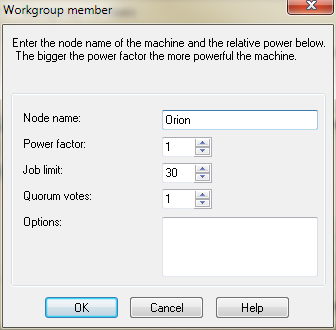When you add a new member node to a Workgroup, you also set several factors that will determine the behavior of jobs on that node in the Workgroup. These factors will determine the efficiency of job processing (load balancing) and the fault tolerance of your workgroup. The factors that will determine the way the Workgroup operates when using the least busy node method of execution.

The factors are:
Power factor: This factor determines the priority that the node will have when running jobs on the least busy node. The determination of this factor should be based on the power of the node and it's ability to process job submissions efficiently. The most powerful node in the cluster should be assigned a power rating and all other nodes can be assigned lower ratings depending on their relative power compared to that node. For instance if the most powerful node is given a rating of 8 and the closest machine is 3/4 as powerful, that machine should be given a rating of 6 etc.
Job Limit: This determines how many jobs will be allowed to run on a node at any given time in the Workgroup. If the job limit is reached, the next job will run on the next least busy node or wait if no nodes are available.
Quorum Votes: The number of Quorum votes you assign a node determines whether it will continue to submit jobs in case a portion of the network is inaccessible. In such a case, the remaining nodes must have more than 50% of the quorum votes for processing to continue. For instance if you have 4 nodes with a total of 12 votes, 3 on each node, and 2 go down, processing will cease if 2 of the 4 nodes become inaccessible. If one of the nodes becomes accessible, job processing will resume, since the quorum votes will be 9 (3 nodes X 3).
![]()
![]() In order to add the new member node to the Workgroup:
In order to add the new member node to the Workgroup: